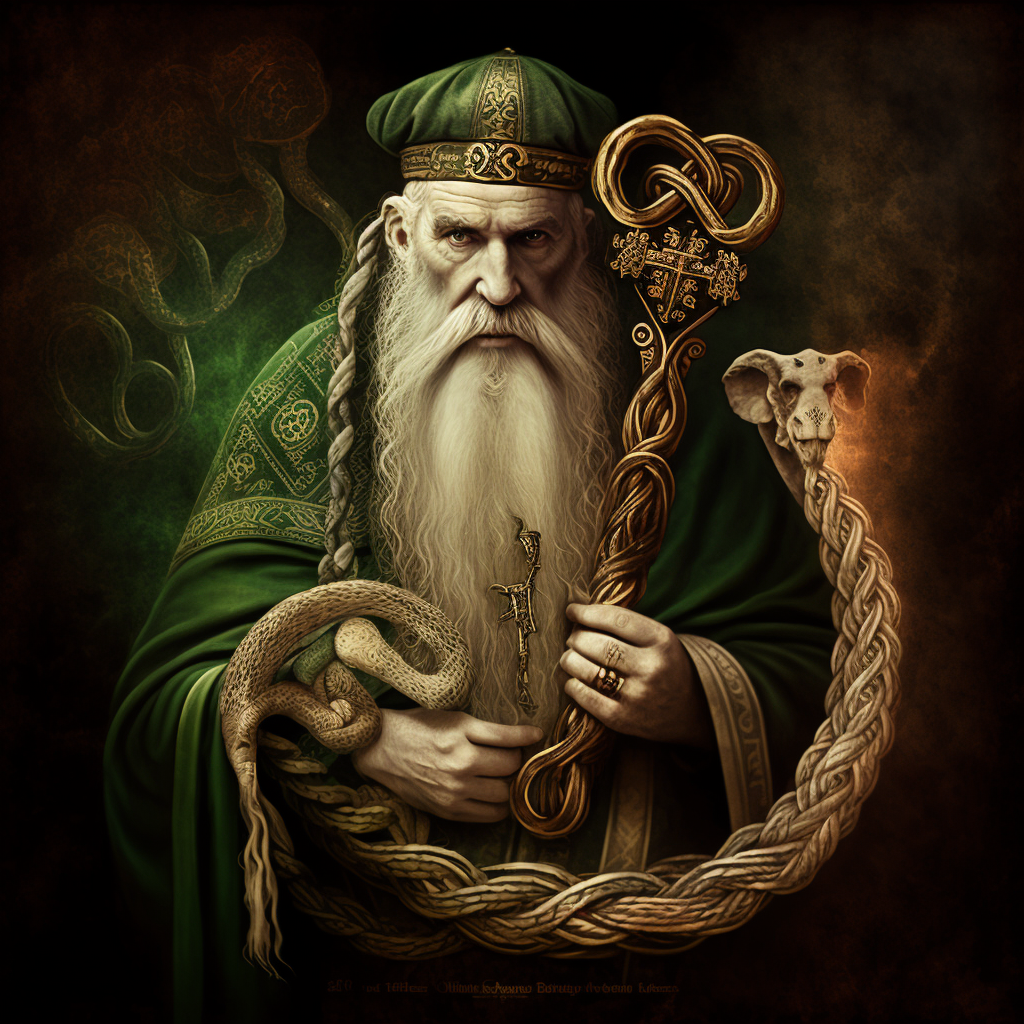The Mythology of St. Patrick’s Day
St. Patrick’s Day is a widely observed celebration that is frequently connected to leprechauns and green beer. The mythology of St. Patrick’s day has been frequently ignored, however. In this piece, we’ll look at the spiritual significance of St. Patrick’s Day and how it can change your soul.
The Mythology of St. Patrick’s Day
St. Patrick’s Day is celebrated on March 17th each year and is a holiday that originated in Ireland. St. Patrick’s Day honors the passing of the patron saint of Ireland. St. Patrick was born in Britain, but when he was a young man, he was taken prisoner by Irish pirates and transported to Ireland as a slave. He converted to Christianity while in captivity and ultimately fled back to Britain. He is attributed with converting the Irish to Christianity when, later in his life, he returned to Ireland as a missionary.
One of the most well-known stories involving St. Patrick is the one about him driving snakes out of Ireland. The legend holds that St. Patrick expelled all the snakes from Ireland by using the force of his faith, freeing the country from their negative impact.
Nevertheless, despite its widespread belief, there is little proof that this tale is based on actual historical events. In reality, due to the island’s geographic isolation and chilly climate, it is widely believed that there were never any snakes in Ireland to begin with.
It is more probable that the story of St. Patrick and the snakes is a metaphor for the saint’s role in bringing Christianity to Ireland and its people. The serpent, a representation of the paganism that predominated in Ireland before Christianity arrived, may have served as a metaphor for the victory of Christianity over its rival paganism.
The holiday known as St. Patrick’s Day honors St. Patrick, who is generally regarded as the patron saint of Ireland, as well as his life and legacy. The celebration, which has Catholic Church origins and is typically linked to the color green, parades, and Irish culture, has developed over time to become a more secular holiday that is observed by people from all cultures and faiths.
St. Patrick’s Day is now a time to honor Irish heritage and culture, wear green, consume green beer, and spend time with loved ones. Although the story of St. Patrick removing the snakes from Ireland may only be a myth, it still serves as a testament to the strength of faith and the lasting influence of one of Ireland’s most revered saints.
“May the blessings of St. Patrick’s day be upon you. May the Irish angels smile upon you. May the luck of the Irish enfold you. May the blessings of Saint Patrick behold you.”
– Unknown
The True Story Behind St. Patrick’s Day
Some believe there’s a darker side to the holiday, for instance, that it has been used to advance nationalist and exclusive viewpoints, especially in light of the background of British colonial rule in Ireland. Some contend that while St. Patrick’s Day celebrations can be seen as a means of expressing Irish identity and cultural pride, they can also serve to deepen rifts between various groups and advance a limited and exclusive view of what it means to be Irish.
Concerns have also been raised about how the customary St. Patrick’s Day tale has been used to support colonialism and oppression. Many people believe that the story of St. Patrick tends to obscure the complicated and frequently violent history of religious and cultural conflict in Ireland. The story is frequently told as a tale of Christian missionary activity and the conversion of the Irish people to Christianity.
Before Christianity became widely practiced in Ireland, a type of pagan animism with strong ties to the seasons and natural world predominated. The complex system of gods, rituals, and beliefs that this religion, also known as Celtic paganism, was defined by, differed from region to region.
Celtic paganism had a rich and varied mythology and folklore, and many aspects of this religion have persisted in Irish society up until the present. The deity Lugh, the goddess Morrigan, and the goddess Brigid are some of the most well-known characters from Celtic mythology.
Despite the fact that Celtic paganism was widely practiced in Ireland before Christianity arrived, scholars continue to disagree on the precise makeup and scope of this faith. This is partly because a great deal of Celtic paganism’s knowledge was passed down orally, and because Christian monks, who were frequently hostile to the older pagan traditions, produced the majority of the written documents that have survived from this time.
Whatever the case, a complicated interplay of cultural, political, and religious variables contributed to the gradual spread of Christianity in Ireland over a period of several centuries. St. Patrick, St. Brigid, and St. Columba are three important individuals in the early Christianization of Ireland who each made a major contribution to the establishment of the church and the conversion of the Irish to Christianity.
Overall, the traditional story of St. Patrick’s Day is complex and multifaceted, and it is important to approach it with a critical and nuanced perspective. While the holiday can be a celebration of Irish identity and culture, it’s also critical to recognize the less positive elements of Irish history and its cultural influence.
The Spiritual Symbolism of St. Patrick’s Day
St. Patrick’s Day has deep spiritual significance for many people, particularly those of Irish descent. The holiday is often associated with the Christian concept of the Holy Trinity, which is symbolized by the three leaves of the shamrock, a plant that is closely associated with Ireland.
Trinity
The Holy Trinity is a central tenet of Christianity, representing the Father, Son, and Holy Spirit. For many people, the symbolism of the Holy Trinity represents the interconnectedness of all things and the unity of the divine. The shamrock is also associated with good luck and fortune in Irish folklore.
In esoteric circles, the symbolism of the Holy Trinity is often associated with the concept of mind, body, and spirit, representing the three aspects of human consciousness that must be integrated in order to achieve spiritual enlightenment.
The Celtic knot, though not directly associated with St. Patrick’s Day itself, is another prominent symbol rooted in the pre-Christian religions of Ireland, and is a complex, interlacing pattern that is often used in Celtic art and design. It is believed to represent the interconnectedness of all things, and the continuity of life and eternity. The endless knot is a common variation of the Celtic knot, and it represents the cyclical nature of life and the universe.
Both the shamrock and the Celtic knot represent the idea of interconnectedness and unity. The shamrock represents the unity of the Holy Trinity, while the Celtic knot represents the interconnectedness of all things in the universe.
In addition, both symbols have a deep connection to nature and the natural world. The shamrock is a plant that is closely tied to the Irish landscape, while the Celtic knot often incorporates elements of nature such as leaves, vines, and flowers.
Snakes
The legend of St. Patrick driving the snakes out of Ireland is also rich in symbolism. Snakes have been associated with evil and darkness in many cultures throughout history, and in Christian symbolism, the serpent represents Satan and temptation.
In esoteric circles, the serpent is often associated with the kundalini energy that lies dormant at the base of the spine and is said to rise up through the chakras, bringing enlightenment and spiritual transformation. In this light, the snake symbolizes not evil but the ability to transform and evolve the human form, spirit, and soul.
Rainbow, Pot of Gold, and Leprechauns
Finally, in Irish folklore, rainbows are believed to be the pathways between heaven and earth, and are associated with good luck, hope, and blessings. The rainbow’s vibrant colors are thought to represent the diversity of life and the interconnectedness of all things.
The pot of gold is often depicted as being at the end of the rainbow in Irish folklore. It is said to be guarded by leprechauns, mischievous fairy-like beings who are often associated with luck and good fortune. The pot of gold is a symbol of abundance and prosperity, and may represent the reward that comes from following one’s dreams and persevering through adversity.
Leprechauns, on the other hand, are often seen as a representation of the trickster archetype in Irish mythology (read more about the Trickster archetype). They are known for their mischievousness, but they are also regarded as protectors of the natural world and guardians of ancient knowledge. They are often associated with the earth element and the natural world, and may represent the importance of staying connected to the land and to our roots.
Overall, the symbolism of the rainbow, pot of gold, and leprechauns in relation to St. Patrick’s Day can be interpreted as representing hope, abundance, and the importance of staying connected to the natural world and our roots.
“St. Patrick‘s Day is an enchanted time — a day to begin transforming winter’s dreams into summer’s magic.”
– Adrienne Cook
Dark Night of the Soul and St. Patrick’s Day
While St. Patrick and the idea of the “Dark Night of the Soul” are not directly related, the life and spiritual path of St. Patrick can be seen as an illustration of the kind of experience that can result in a Dark Night.
The Dark Night of the Soul is a spiritual crisis that can be a transformative experience for your soul. Trauma or tragedy are common triggers for this crisis, which triggers people to reevaluate how they see the world.
According to legend, St. Patrick was a missionary who preached Christianity to the Irish in the fifth century. He is renowned for his tenacious work to disseminate the gospel and for helping to found the church in Ireland.
St. Patrick’s own spiritual path, though, was not without its difficulties. He was abducted as a young man and brought to Ireland as a prisoner. In order to find comfort and a link to a higher power during this period of intense loneliness and isolation, he turned to prayer and meditation.
St. Patrick continued to battle with his faith and have doubts after he managed to flee and return to his native country. He spent many years alone, spending a great deal of time in prayer and meditation, and trying to comprehend his faith better.
This time of intense internal conflict and doubt can be viewed as a type of “Dark Night of the Soul,” a life-changing experience that forced St. Patrick to reevaluate his beliefs and discover a stronger sense of meaning and kinship with the divine.
Overall, St. Patrick’s life story and his journey of spiritual transformation serve as an illustration of the kinds of experiences that can result in a Dark Night of the Soul and the ways in which this type of crisis can eventually lead to greater understanding, growth, and connection to the divine. This holiday can serve as a potent recall to welcome the challenging times in our lives as chances for personal development and transformation.
Ideas to Celebrate St. Patrick’s Day in a Spiritual Way
Try celebrating St. Patrick’s Day in a spiritual manner rather than concentrating on its modern-day customs. Here are some suggestions:
- Take an outdoor walk to see the rebirth of spring. Renew your connection to and veneration of the Earth.
- Think about the significance of the trinity, the color green, and beliefs surrounding “luck”
- Spend some time in meditation or contemplating your own experience with transformation and/or the Dark Night of the Soul.
- Explore your ancestors’ spiritual practices and, if you’re Irish, make a connection with them.
Conclusion
In conclusion, St. Patrick’s Day is a widely observed holiday that celebrates the life and legacy of Ireland’s patron saint, St. Patrick. Even though the holiday has come to be associated with modern traditions like leprechauns and green beer, it holds profound spiritual importance for many people, especially those of Irish ancestry. The three shamrock leaves, which are symbolic of the Holy Trinity in Christianity, are the holiday’s foundation. The Celtic knot, which symbolizes interconnectedness and togetherness, is also linked to the holiday. The story of St. Patrick driving snakes from Ireland is full of symbolism, with the snake standing for temptation and evil as well as having the power to change and advance the human body, spirit, and mind. Last but not least, the life of St. Patrick and his journey of spiritual transformation serve as an example of the kinds of experiences that can result in a “Dark Night of the Soul” and the ways in which this kind of crisis can ultimately lead to greater knowledge, development, and connection to the divine.
References:
- “St. Patrick’s Day: History, Myths and Traditions.” History.com, A&E Television Networks, 5 March 2021, https://www.history.com/topics/st-patricks-day/history-of-st-patricks-day-2
- “St. Patrick’s Day: The True Story.” National Geographic, 14 March 2014, https://www.nationalgeographic.com/news/2014/3/140314-st-patricks-day-2014-snakes-ireland-irish-nation-parade-history/
- Cook, Adrienne. “St. Patrick’s Day and the Dark Night of the Soul.” Spirituality & Health, 14 March 2018, https://spiritualityhealth.com/articles/2018/03/14/st-patricks-day-and-the-dark-night-of-the-soul
- “The Spiritual Significance of St. Patrick’s Day.” HuffPost, 17 March 2015, https://www.huffpost.com/entry/the-spiritual-significanc_b_6898564
- “The Shamrock and the Celtic Knot: Symbols of St. Patrick’s Day.” IrishCentral, 15 March 2021, https://www.irishcentral.com/roots/the-shamrock-and-the-celtic-knot-symbols-of-st-patricks-day
Schedule a Session With Me
If you’d like to go deeper in a supportive, healing environment, please visit my scheduling page.




